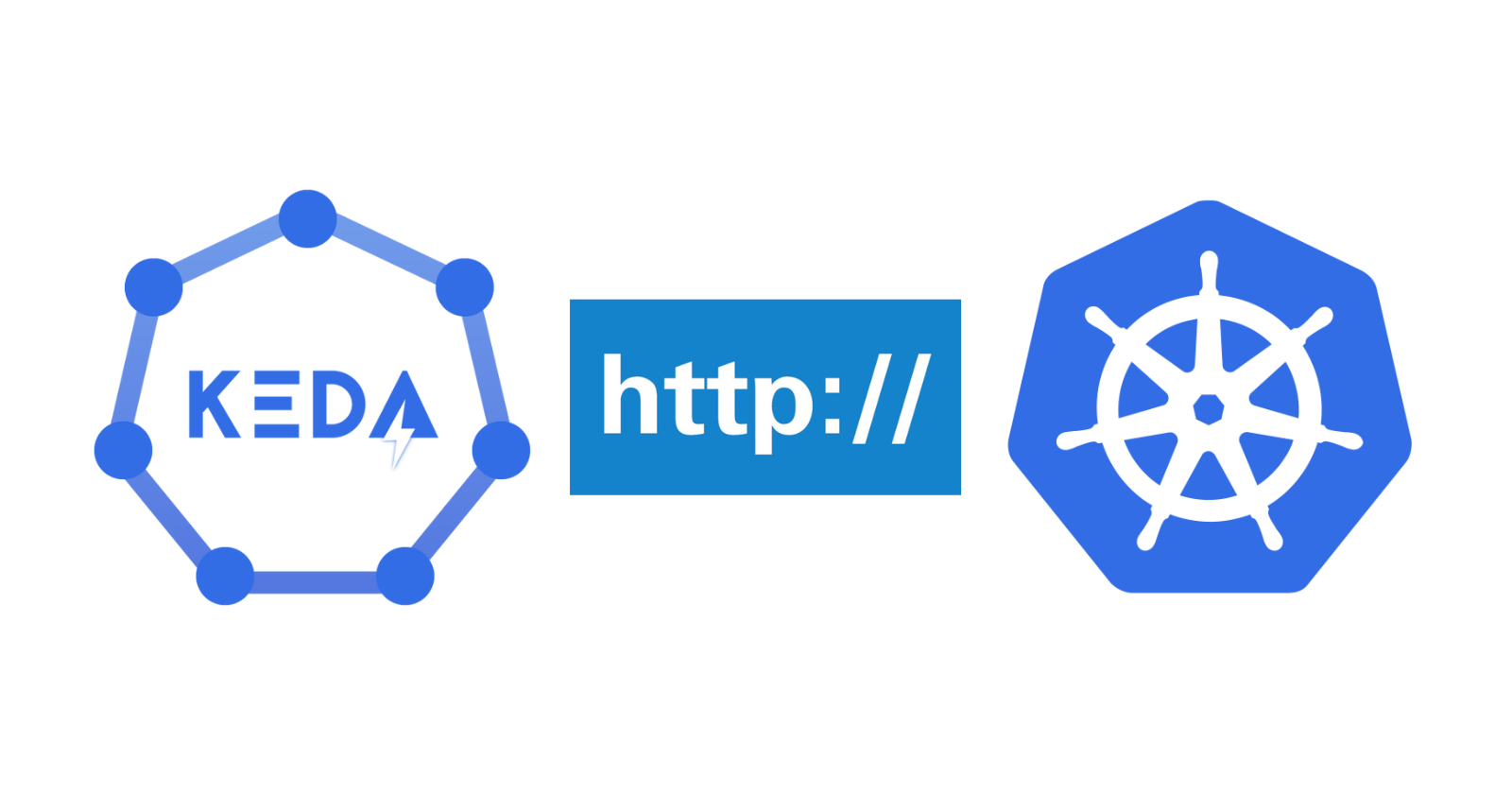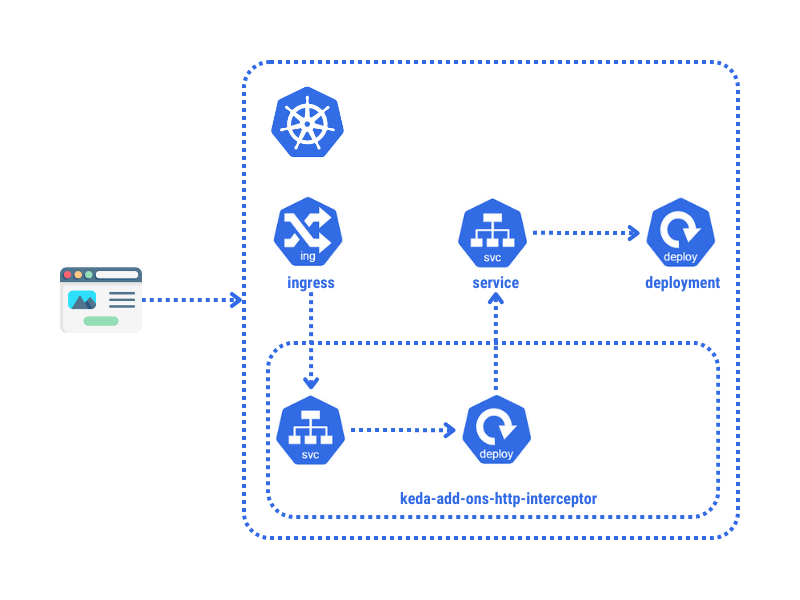Scaling Kubernetes Pods Based on HTTP Traffic using KEDA HTTP Add-on
 Raul Naupari
Raul Naupari
In a previous article, we demonstrated how to scale pods based on HTTP traffic using KEDA and CloudWatch. We utilized CloudWatch to store and retrieve the metrics for our application and, based on that, scale the number of pods. But is there a way to achieve the same result using only KEDA? The answer is yes, with the KEDA HTTP add-on.
The KEDA HTTP Add-on allows Kubernetes users to automatically scale their HTTP servers up and down (including to/from zero) based on incoming HTTP traffic.
How does it work?
A typical application on Kubernetes uses an ingress to route requests to a service, which then routes them to the pods for handling.

There are three main components provided by the KEDA HTTP Add-on:
Operator: This component listens for events related to
HTTPScaledObjectresources and creates, updates, or removes internal mechanisms as needed.Interceptor: This component accepts and routes external HTTP traffic to the appropriate application.
Scaler: This component monitors the size of the pending HTTP request queue for a given application and reports it to KEDA.
As a result, once the KEDA HTTP Add-on is installed in our cluster, we need to route the traffic from the ingress to the interceptor manually. The interceptor will then route the request back to our original service.

Pre-requisites
Install Docker Desktop
Enable Kubernetes (the standalone version included in Docker Desktop)
Install Helm CLI
Follow the instructions in the post Testing the NGINX Ingress Controller locally to set up the ingress.
Enable the Kubernetes Metrics Server on Docker Desktop. Run the command
kubectl apply -f components.yaml. You can find thecomponents.yamlfile here.Follow the instructions in the post Horizontal Pod Autoscaling with Kubernetes Event-Driven Autoscaler to install KEDA.
Install K6.
Installation
The KEDA HTTP Add-on uses Helm for installation in the cluster. Execute the following command:
helm install http-add-on kedacore/keda-add-ons-http --namespace keda --set interceptor.responseHeaderTimeout=5s
We are customizing the default installation by passing the parameter --set interceptor.responseHeaderTimeout=5s on the command line. Since we are introducing a random delay in our application between 0 and 1.5 seconds, this setup will prevent a Bad Gateway response from the interceptor to the caller. The complete list of parameters and descriptions can be found here.
The above command installed the HTTP Add-on in cluster-global mode. Add
--set operator.watchNamespace=<target namespace>to install the HTTP Add-on in namepaced mode. If you do this, you must also install KEDA in namespaced mode and use the same target namespace.
The Application
Run the following commands to set up the solution:
dotnet new webapi -n MyWebApi
dotnet new sln -n MyWebApi
dotnet sln add --in-root MyWebApi
Open the Program.cs file and update the content as follows:
var builder = WebApplication.CreateBuilder(args);
builder.Services.AddEndpointsApiExplorer();
builder.Services.AddSwaggerGen();
var app = builder.Build();
if (app.Environment.IsDevelopment())
{
app.UseSwagger();
app.UseSwaggerUI();
}
app.UseHttpsRedirection();
var summaries = new[]
{
"Freezing", "Bracing", "Chilly", "Cool", "Mild", "Warm", "Balmy", "Hot", "Sweltering", "Scorching"
};
app.MapGet("/weatherforecast", async () =>
{
var delay = Random.Shared.Next(0, 1500);
await Task.Delay(delay);
Console.WriteLine($"New request {DateTimeOffset.UtcNow} with delay of {delay} ms");
var forecast = Enumerable.Range(1, 5).Select(index =>
new WeatherForecast
(
DateOnly.FromDateTime(DateTime.Now.AddDays(index)),
Random.Shared.Next(-20, 55),
summaries[Random.Shared.Next(summaries.Length)]
))
.ToArray();
return forecast;
})
.WithName("GetWeatherForecast")
.WithOpenApi();
app.Run();
record WeatherForecast(DateOnly Date, int TemperatureC, string? Summary)
{
public int TemperatureF => 32 + (int)(TemperatureC / 0.5556);
}
A random delay is added to each request to simulate slower processing time.
Docker Image
At project level, create a Dockerfile with the following content:
FROM mcr.microsoft.com/dotnet/aspnet:8.0 AS base
USER app
WORKDIR /app
EXPOSE 8080
EXPOSE 8081
FROM mcr.microsoft.com/dotnet/sdk:8.0 AS build
ARG BUILD_CONFIGURATION=Release
WORKDIR /src
COPY ["MyWebApi/MyWebApi.csproj", "MyWebApi/"]
RUN dotnet restore "./MyWebApi/MyWebApi.csproj"
COPY . .
WORKDIR "/src/MyWebApi"
RUN dotnet build "./MyWebApi.csproj" -c $BUILD_CONFIGURATION -o /app/build
FROM build AS publish
ARG BUILD_CONFIGURATION=Release
RUN dotnet publish "./MyWebApi.csproj" -c $BUILD_CONFIGURATION -o /app/publish /p:UseAppHost=false
FROM base AS final
WORKDIR /app
COPY --from=publish /app/publish .
ENTRYPOINT ["dotnet", "MyWebApi.dll"]
Build the image by running the following command at the solution level:
docker build -t raulnq/mywebapi:1.0 -f .\MyWebApi\Dockerfile .
Kubernetes
Create a resources.yaml file with the following content:
apiVersion: apps/v1
kind: Deployment
metadata:
name: api-deployment
labels:
app: api
spec:
replicas: 1
selector:
matchLabels:
app: api
template:
metadata:
labels:
app: api
spec:
containers:
- name: api-container
image: raulnq/mywebapi:1.0
imagePullPolicy: IfNotPresent
ports:
- name: http
containerPort: 8080
protocol: TCP
---
apiVersion: v1
kind: Service
metadata:
name: api-service
labels:
app: api
spec:
type: ClusterIP
ports:
- port: 80
targetPort: 8080
protocol: TCP
name: http
selector:
app: api
---
The first part of the file contains standard Deployment and Service definitions. Let's add the following content:
kind: Service
apiVersion: v1
metadata:
name: keda-interceptor-proxy
spec:
type: ExternalName
externalName: keda-add-ons-http-interceptor-proxy.keda.svc.cluster.local
---
apiVersion: networking.k8s.io/v1
kind: Ingress
metadata:
name: api-ingress
spec:
ingressClassName: nginx
rules:
- host: www.api.com
http:
paths:
- path: /
pathType: Prefix
backend:
service:
name: keda-interceptor-proxy
port:
number: 8080
---
In this section, we want to set up the ingress rule to route requests to the keda-add-ons-http-interceptor-proxy service. However, there is a problem: the service is in a different namespace, and the Kubernetes documentation states:
A
Resourcebackend is an ObjectRef to another Kubernetes resource within the same namespace as the Ingress object.
The solution is to create a service with the type ExternalName in our namespace, referencing the keda-add-ons-http-interceptor-proxy service. Then, we can use this service in the ingress rule. The final part is the HTTPScaledObject resource:
kind: HTTPScaledObject
apiVersion: http.keda.sh/v1alpha1
metadata:
name: api-scaledobject
spec:
hosts:
- www.api.com
scaleTargetRef:
name: api-deployment
kind: Deployment
apiVersion: apps/v1
service: api-service
port: 80
replicas:
min: 1
max: 10
scalingMetric:
requestRate:
granularity: 1s
targetValue: 5
window: 1m
The HTTPScaledObject is a custom resource definition (CRD) that allows us to configure HTTP-based autoscaling for our applications:
host: These are the hosts to which this scaling rule will apply.scaleTargetRef: Describes which workload to scale and the service to route HTTP traffic to.nameandkind: Defines the workload to scale, in this case, aDeployment.serviceandport: This is the service to route traffic to.apiVersion: This is the API version of the workload to scale.
scalingMetric: Describes how the workload should scale.requestRatetargetValue: Defines the value for the scaling configuration.windows: Defines the aggregation window for the request rate calculation.granularity: Defines the granularity of the aggregated requests for the request rate calculation.
The complete specification can be found here. Run the following command to deploy the resources to the cluster:
kubectl apply -f resources.yaml
Tests
Create a load.js file with the following content:
import http from 'k6/http';
import { sleep } from 'k6';
export const options = {
vus: 50,
duration: '600s',
};
export default function () {
http.get('http://www.api.com/weatherforecast');
sleep(1);
}
Execute the script using the command:
k6 run load.js
After a couple of minutes, check the number of pods for our deployments using the command kubectl get pods to see an output like:
NAME READY STATUS RESTARTS AGE
api-deployment-8486cd99df-4cbp6 1/1 Running 0 14h
api-deployment-8486cd99df-69w4w 1/1 Running 0 40s
api-deployment-8486cd99df-d5zzp 1/1 Running 0 40s
api-deployment-8486cd99df-rhsxr 1/1 Running 0 40s
KEDA HTTP Add-on is still in beta and not yet recommended for production use. We need to value the benefits against the risks. It's important to note that with this approach, we are adding a new piece of software to our system: the proxy. Therefore, we must monitor and size it according to our workloads. You can find the code and scripts here. Thank you, and happy coding.
Subscribe to my newsletter
Read articles from Raul Naupari directly inside your inbox. Subscribe to the newsletter, and don't miss out.
Written by

Raul Naupari
Raul Naupari
Somebody who likes to code